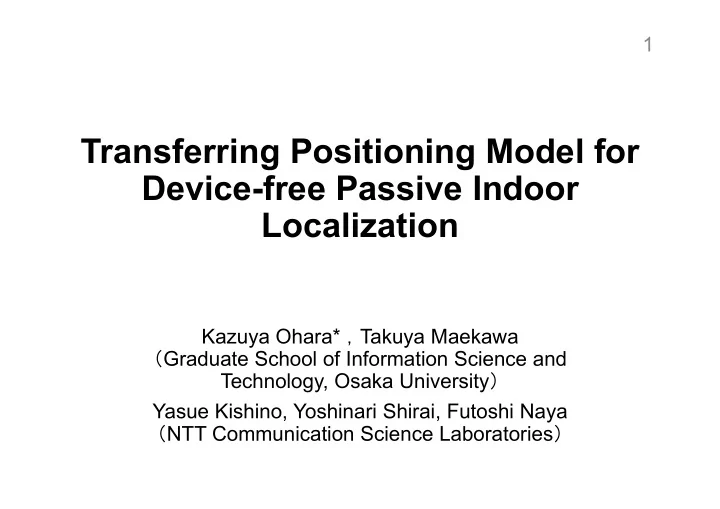

1 Transferring Positioning Model for Device-free Passive Indoor Localization Kazuya Ohara* , Takuya Maekawa ( Graduate School of Information Science and Technology, Osaka University ) Yasue Kishino, Yoshinari Shirai, Futoshi Naya ( NTT Communication Science Laboratories )
2 Research Background Device-free passive indoor positioning Estimate position of person • surveillance of elderly person � in indoor environment • smart homes automation Need not to carry any device �𝑦 � , 𝑧 � � R2 RSSI RSSI Positioning Model R1 R2 R1 R2 �𝑦 � , 𝑧 � � �𝑦 � , 𝑧 � � RSSI RSSI R1 human body interferes R1 R2 R1 R2 Receiver Wi-Fi AP
3 Research Purpose Issue Issue Collecting labeled training data at many positions in the target environment is costly Purpose Purpose Construct an indoor positioning model by transferring training data from other environments (source environments) transfer target environment source environment Training points AP Receiver between AP and receiver
4 Approach variance raw RSSI -49 2 -50 RSSI[dBm] 1.5 Variance raw signal strength -51 1 -52 0.5 -53 variance of signal strength -54 0 to track the person 0 2 4 6 8 10 Time[s] variance model transfer Variance Variance Position Position AP Receiver AP Receiver source environment target environment
5 Overview of proposed method Learning variance model Learning positioning model in source environments for target environment Transfer Learn variance models model Learn Floor plan variance model ( x 1 ,y 1 ) ( x 1 ,y 1 ) Floor plan of Positioning target env. model Wi-Fi data
6 Proposed method (Necessary information) source environment target environment ? RSSI RSSI RSSI RSSI t t t t Floor plans (layout of walls) Floor plans (layout of walls) RSSI when there is no person RSSI when there is no person Unlabeled RSSI Labeled RSSI e.g. by video recording
7 Learning variance model Example data signal strength variance values when the person passed each position Variance Become larger as the path becomes closer to device Receiver AP ⋯ Human body interferes signal more 0.5m 0.5m Passing position Variance model 𝑤�𝑦� Bimodal model Largest at AP and Receiver mixture of 2 Gaussian functions 𝑦 𝑦 : passing point, 𝑤�𝑦� : variance value
8 Learning variance model Example data signal strength variance values when the person passed each position Wall Variance Feature depends greatly on the area divided by walls Receiver AP 0.5m 0.5m ⋯ Passing position Variance model Variance model Variance model variance variance Position Position sub-line segment
9 Transferring variance model 1. Find top-k similar source sub-line segments i. the same end points of sub-line segment ii. the same number of walls iii. kNN search according to three criteria target sub-line segment source environment 2. Transferring variance model Averaging parameters of top-k source models target model parameter
10 Transferring variance model Criteria used for selecting source sub-line segments with k NN search 1. Length of sub-line segment 2. Signal strength when there is no person materials on segments are similar 3m source target Probability 2m compare distribution RSSI 3. Variance value when a person passes randomly Variance model Frequency variance Frequency Position Variance variance similar Variance Position
11 Transferring variance model Criteria used for selecting source sub-line segments with k NN search 1. Length of sub-line segment 2. Signal strength when there is no person materials on segments are similar 3m source target Probability 2m compare distribution RSSI 3. Variance value when a person passes randomly compare Variance source distribution Probability From unlabeled data Time target Variance outlier detection Variance Time
12 Learning models Passing detection model SVM Detecting whether or not a person passes Hyperplane Training data : variance values observed passing non-passing by selected source sub-line segments Variance Variance
13 Learning models Positioning model Estimate position of a person when passing is detected Compute variance values at some points from a transferred variance model Variance model variance Position Variance Variance Variance Variance Variance Tracking by using particle filter Two positions match
14 Tracking by using particle filter Particle filter Particle : position of a person High density particles High probability that the person is there t-2 t-1 t t
15 Evaluation (Environments) • 1 Wi-Fi AP and 10 receivers • Walk around for 20 minutes in each environment • Leave-one-out cross-validation evaluation 11.7m 8.4m 10.4m 7.9m 10.4m 16.3m 12.3m 12.9m env.4 env.1 env.2 env.3 AP Receiver
16 Evaluation (Results) Evaluating proposed method Supervised ・・・ trained on labeled data obtained in the same environment Random ・・・ select randomly k sub-line segments while transferring variance model 2.5 distance [m] Supervised 0.08m Error 2.35 2.0 Performance of random was poorer Proposed than with proposed method 1.5 1.71 Random 1.63 1.0 Criteria for selecting source sub-line segments Error distance [m] 2.0 L : Length of sub-line segment 1.9 S : Signal strength when there is no person 1.8 V : Variance value when a person passes randomly 1.7 1.6 “Length” contribute more than other criteria 1.5 “all” achieve best performance all LS LV SV L S V Criteria
17 Conclusion • We proposed a new method that enables us to construct a positioning model for device-free passive indoor localization with little effort • As a part of our future work, we plan to automatically obtain unlabeled data in an end user’s daily life to reduce burdens imposed on the user
Recommend
More recommend